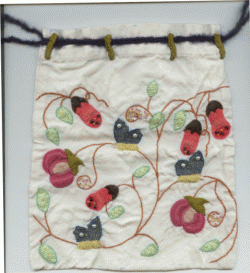 |
Since time immemorial, people have embroidered.
During the middle ages, Embroidery Guilds moved embroidery into a division between "professionals" and "amateurs" and the quality of the work done clearly delineated these categories.
That was until the time of the later Tudors and moving into the Elizabethan era.
At that time; both in England and in the rest of Europe, the quality of the embroidery work done by amateur embroiderers increased to the point where it is almost indistinguishable from that of the professionals. Certainly, by this time the number of stitches used had increased and the method in which materials were used had also changed.
Many people would typify the embroidery of the later Tudors and the Elizabethans as Blackwork embroidery. This distinctive linear style of embroidery appears over and over again in the portraits by Hans Holbein of this period's notables.
Elizabethan embroidery, however, was much much more than just Blackwork: in fact Blackwork was more than what many people think it was.
When Elizabeth 1 ascended the throne the attitude towards women had markedly changed. Women were loosing a lot of their independence.
With the end of the Feudal System in most of Europe men were staying home more and were living longer. Thus, control of the land and estates moved out of the hands of women and into the hands of men. Reading and Writing were no longer considered "womanly" lessons, and were now considered essential for a gentleman.
Thus, we see women moving out of the estate Office and into the Solar and Still Room.
With more time on their hands, women were able to take up hobbies that had once been necessity. Plain sewing was still done, but women also took up embroidery and much plain sewing was farmed out to professional seamstresses. In a way, this completely swapped around the previous way of life, with all plain sewing once being done by the women of the household and embroidery done by professionals.
Of course, the great Plague of the 15th Century had had a great impact on the way people lived. For instance, whole towns were wiped out - notably Sheffield in England where the art of making fine needles was almost lost. Whole chapters of Embroidery Guilds were wiped out by the Plague and women started to learn to stitch in earnest.
And yes - the picture above is an Elizabethan Swete Bag that I've stitched.
Links
Blackwork Archives
Elizabethan Embroidery Page
Renaissance Dying Elizabethan Hand Dyed Embroidery Thread
Recommended Reading
"Beginners Guide to Crewel Embroidery" by Jane Rainbow
"Crewel Embroidery" by Sue Hawkins
"An Elzabethan Inheritance: The Hardwick Hall Textiles" by Santina M Levy
Is there anything that you would particularly like to see an article on? If so, please contact me with your suggestions.
Happy Stitching

© 2007 Megan McConnell


